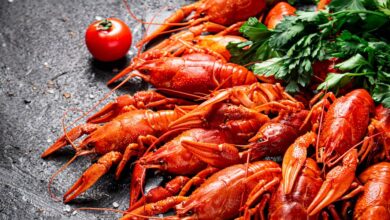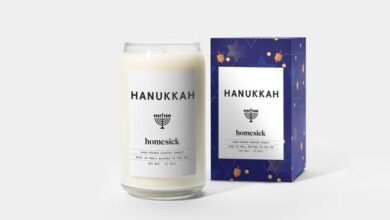35 Surprising Christmas Facts – Christmas Trivia You Should Know

For those of us who are a little out practice when it comes to dinner table conversation or you need to redirect the topic away from controversial fare, these Christmas facts will come to your rescue. You can also use them to spice up your annual Christmas letter, give your social media posts some flare, or study up for holiday-themed trivia night. It’s likely not news to anyone that there’s a lot more to Christmas than giving and receiving gifts (although we’ve got great 2021 gift ideas too!), wearing festive Christmas sweaters and decking the halls with Christmas decorations that make your abode look like Santa’s workshop. It’s an age-old celebration with centuries of tradition and deep symbolism behind virtually every aspect of the holiday.
From the religious elements you may already enjoy every year to pagan origins and some factoids that are just purely entertaining, even the holly jolliest Christmas fans will learn something from this list. There’s a little something that touches on every aspect of the holiday. Take a few moments out from the breakneck pace of the holiday season, grab a Christmas cookie and check this list twice.
1
Christmas wasn’t always on December 25
While Christmas celebrates the birth of Jesus Christ, the actual date is lost to history. There’s no mention of December 25 in the Bible and many historians say Jesus was really born in the spring. Some historians posit the date was originally chosen because it coincided with the pagan festival of Saturnalia, which honored the agricultural god Saturn with celebrating and gift-giving.
2
Gifts have both Christian and Pagan origins
Christians may have grown up learning that we give gifts at Christmas to mimic the presents the Three Wise Men brought the baby Jesus. But like so many other traditions, that also has its roots in Saturnalia. The pagans originally gave offerings to the gods, too.
3
Evergreens are an ancient tradition
4
You can thank Prince Albert for your Christmas tree
Brew a cup o’ tea when trimming your tree this year to pay homage to its origins. When Prince Albert of Germany got a tree for his new wife, Queen Victoria of England, it really took off across the pond. A drawing of the couple in front of a Christmas first tree appeared in Illustrated London News in 1848. To use modern parlance, the idea went viral.
5
St. Nick was more generous than jolly
You probably already knew that the idea of Santa Claus came from St. Nicholas. The saint wasn’t a bearded man who wore a red suit; that tradition came much later. In the fourth century, the Christian bishop gave away his large inheritance to the poor and rescued women from servitude. In Dutch, his name is Sinter Klaas, which later morphed into Santa Claus in English.
6
The Dutch gave us the idea to leave cookies and milk
If your kids leave Santa a little snack to keep him sated on your journey, thank the Dutch. On St. Nicholas’ feast day on Dec. 6, Dutch children leave him food and drink to be exchanged for gifts overnight.
7
Coca-Cola played a part in Santa’s image
Before Coca-Cola decided to use his image for advertising, Santa’s looks tended more spooky than jolly. Then, in 1931, the beverage company hired an illustrator named Haddon Sundblom to depict the jolly old elf for magazine ads. Now, kids see visions of sugarplums instead of having Santa-themed nightmares.
8
Hanging stockings started by accident
Legend has it, we hang stockings by the chimney with care thanks to a poor man who didn’t have enough money for his three daughters’ dowries. Generous old St. Nick dropped a bag of gold down their chimney one night after the girls had hung their freshly-washed stockings there to dry. That’s where the gold ended up, and the tradition stuck.
9
Rudolph was a marketing ploy
Rudolph the Red-Nosed Reindeer first appeared in 1939 when the Montgomery Ward department store asked one of its copywriters to create a Christmas story for kids that the store could distribute as a promotion. The adorable movie featuring the island of misfit toys and Herbie the elf hit the airwaves (and our hearts) in 1964.
10
Black Friday isn’t the busiest shopping day
Black Friday, or the day after Thanksgiving, certainly sees lots of shoppers heading to the mall. But we must be a nation of procrastinators, because the most hectic days of the year are actually the Friday and Saturday before Christmas so plan ahead if you don’t care for crowds.
11
The eight tiny reindeer have had lots of names
Rudolph was almost named Rollo or Reginald, which doesn’t quite have the same ring to it. But his crew also had lots of other names. They’ve also been called Flossie, Glossie, Racer, Pacer, Scratcher, Feckless, Ready, Steady and Fireball.
12
Christmas wreaths are religious symbols
The Christmas wreath first originated as a symbol of Christ. The holly represents the crown of thorns Jesus wore at his crucifixion and the red berries stand for the blood he shed. So when you see a wreath this holiday, you’ll remember the reason for the season.
13
“Jingle Bells” was originally a Thanksgiving song
Turns out, we first started dashing through the snow for an entirely different holiday. James Lord Pierpont wrote the song called “One Horse Open Sleigh” for his church’s Thanksgiving concert in the mid-19th Century. Then in 1857, the song was re-released under the title we all know and love. Today, it’s still among the most popular Christmas songs.
14
Astronauts broadcast “Jingle Bells” from space
Many of us have done a prank that almost went too far. Nine days before Christmas in 1965, two astronauts aboard the Gemini 6 told Mission Control that they saw an “unidentified flying object” about to enter Earth’s atmosphere, traveling in the polar orbit from north to south. Just as things got tense, they interrupted the broadcast with “Jingle Bells,” as Wally Schirra played a small harmonica accompanied by Tom Stafford shaking a handful of small sleigh bells.
15
Silent Night is the most recorded song
We all know the same few handfuls of Christmas songs play at stores and on the radio in a loop all season long. But one of them has been adapted more than others. Silent Night ears that title, as the most-recorded Christmas song in history. It’s had more than 733 different versions copyrighted since 1978.
16
Celebrating Christmas used to be illegal
From 1659–1681, anyone caught making merry in the colonies would face a fine for celebrating. By the Revolutionary War, the day had so little significance that Congress even held their first session on December 25, 1789. Christmas wasn’t even proclaimed a federal holiday for almost another century, proving that the Grinch’s attitude toward the holiday was alive and well long before he was.
17
Settlers created the first American eggnog
The Jamestown settlers created the first American batch of eggnog, although it likely bore little resemblance to today’s comforting tipple. The word nog comes from the word grog; or any drink made with rum. An early nog didn’t have the rich, milky base we now ladle out of grandma’s cut-crystal punch bowl.
RELATED: 50 Boozy Christmas Cocktails That Are Sure To Get You Into the Christmas Spirit
18
Christmas decorating sends nearly 15,000 people to the ER
If you’ve ever watched Clark Griswold decorate his house in Christmas Vacation, that stat likely doesn’t shock you. In fact, the Consumer Product Safety Commission estimates that 14,700 people visit hospital emergency rooms each November and December from holiday-related decorating accidents. So please, be careful when you’re putting up the holly and the ivy.
19
Santa has his own Canadian postal code
Every year, letters to Santa Claus flood post offices across the world, putting parents in a tough spot as they figure out how to answer them or explain why their kids’ letters got lost in the mail. Cementing their reputation as some of the nicest people ever, some big-hearted Canadian Post Office workers started writing back. As the program took off, they set up a special postal code for Santa as part of a Santa Letter-Writing Program initiative: HOH OHO.
20
Dry Christmas trees spark more than joy
21
We ship a ton of packages at the holidays
Between Thanksgiving and New Year’s Day, the U.S. Postal Service delivered an estimated 910 million packages in 2019 — in addition to almost 15 billion pieces of mail. That includes gifts for loved ones, cards and Christmas letters, missives to Santa and those dreaded holiday credit card bills. That’s why it’s so important to thank our mail carriers. They work harder than Santa’s elves!
22
The term “Xmas” dates back to the 1500s
Contrary to popular believe, “Xmas” is not a trendy attempt to take Christ out of Christmas. According to From Adam’s Apple to Xmas: An Essential Vocabulary Guide for the Politically Correct, “Christianity” was spelled “Xianity” as far back as 1100. X, or Chi, is the Greek first letter of “Christ” and served as a symbolic stand-in at the time. In 1551, the holiday was commonly called “Xtemmas,” which was later shortened to “Xmas.”
23
The majority of Americans celebrate Christmas
Christmas decorations feel like they appear in stores earlier every year, not to mention ads for gifts everywhere. That’s because the majority of Americans really do jingle bell rock their way right through the season: about 85 percent of us. Not all of those celebrate the religious basis of the holiday, though.
24
Just about half of Americans attend Christmas services
If church attendance on Christmas Eve has felt less busy lately than when you were a kid, you may not be misremembering. The Pew Research Center found that fewer people think of Christmas as a religious holiday these days. Only 51 percent of people who celebrate attend church as part of the festivities. No word on what portion of those also only go on Christmas and Easter.
25
Americans spend nearly $1,000 on gifts
26
Mistletoe is an aphrodisiac
The holiday decoration isn’t just pretty. It’s also an ancient symbol of fertility and virility — and the Druids considered it an aphrodisiac. So the next time someone cracks a joke about meeting you under the mistletoe, consider yourself warned.
27
Mistletoe’s name isn’t as sweet
On the other hand, mistletoe’s name might not give you quite as many warm feelings. Mistle thrush birds eat the plant’s berries, digest the seed, and then help the plant germinate with their droppings. The Germanic word for mistletoe literally means “dung on a twig.” Romantic, right?
28
Ham ranks as the festive favorite
One of the showstoppers of Christmas dinner is carving the roast beast, whatever species it comes from. Google searches for “ham” and “turkey” both spike during the month of December, according to Google Trends data. Spiral-cut ham edges out the bird as the most popular choice for a Christmas table. The jury’s still out on whether people prefer ham or turkey sandwiches the day after, though.
RELATED: 35 Christmas Hams That Taste Amazing and Look Gorgeous on Your Dinner Table
29
Candy canes originated in Germany
The National Confectioners Association says a choirmaster originally gave the red-and-white-striped candies to young children to keep them quiet during marathon church services. Grandmas who still sneak the kids sweets during droning sermons, history is on your side. It wasn’t until a German-Swedish immigrant decorated his tree with candy canes in 1847 that they became popular as a Christmas candy.
30
The Rockefeller Christmas tree started small
The first Christmas tree at Rockefeller Center probably looked more like Charlie Brown’s than the resplendent one today. Construction workers first placed a small, undecorated tree while working there in 1931. Two years later, another tree appeared in its place, this time draped in lights. It just kept getting bigger every year. Today, the majestic tree bears more than 25,000 twinkling lights and sees millions of selfie-takers each season.
31
Washington Irving created many Santa legends
You may know Washington Irving best for The Legend of Sleepy Hollow featuring the famous headless horseman, but he wrote a lot about St. Nicholas, too. In fact, he’s the one who first came up with eight tiny reindeer. He loved Santa Claus so much that in 1835, he helped launch the Saint Nicholas Society of the City of New York, serving as its secretary until 1841.
32
Norway provides the tree in Trafalgar Square
Londoners and visitors alike probably know the iconic spruce that stretches to the sky in Trafalgar Square each year, but few realize it’s an equally iconic holiday gift. Every year since 1947, the people of Norway donate the tree in gratitude for Britain’s support for Norway during World War II. Now that’s what we call goodwill toward men.
33
This Christmas gift held a lifesaving secret
During World War II, The United States Playing Card Company joined forces with American and British intelligence agencies to create a very special deck of cards. They distributed them as Christmas gifts, but they also helped allied prisoners of war escape from German POW camps. When wet, individual cards peeled apart to reveal maps of escape routes. Sometimes truth really is stranger than fiction.
34
Your Christmas tree likely traveled a bit
Unless you fell it yourself, your “fresh” Christmas tree probably spent weeks out of the ground before appearing at your local retailer. And there’s likely not much hiking into the woods involved, either: 98 percent of American trees today grow on farms, mostly in California, Oregon, Michigan, Washington, Wisconsin, Pennsylvania and North Carolina, the country’s top Christmas tree-producing states.
35
Tinsel has a storied history
Tinsel was invented in 1610 in Germany and was originally spun from real silver, making it far from the chintzy decoration it is now. The U.S. government also once banned tinsel because it used to contain poisonous lead. But never fear; now it’s just plastic. It should still be kept away from young kids and pets though, since they could still choke on it.
Writer
When she’s not hunting for compelling personal stories or justifying her love for dessert, Asher can likely be found watching early-2000s TV on Netflix with her husband.
Senior editor
Lizz Schumer is the senior editor for Good Housekeeping, and also contributes to Woman’s Day, and Prevention, covering pets, culture, lifestyle, books, and entertainment.
This content is created and maintained by a third party, and imported onto this page to help users provide their email addresses. You may be able to find more information about this and similar content at piano.io
Source link






